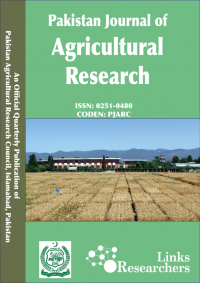DETERMINATION OF FORAGE QUALITY OF INDIGENOUS AND EXOTIC RHODES GRASS ACCESSIONS UNDER RAINFED CONDITIONS
Sohaib Arshad*, Sarwat Naz Mirza*, Imtiaz Ahmad Qamar** and Maqbool Shahbaz**
ABSTRACT
Utilization of grasses as fodder and forage is the most important source of nutrition for cattle as it provides them with metabolizable energy, carbohydrates, proteins and other important minerals. As global warming is increasing, overall water scarcity is resulting in deterioration of natural resources, and it is need of the hour to find fodder crop resources which are more accustomed to change climatic conditions. Hence, different exotic and indigenous varieties of Rhodes grass were tested for quality and yield parameters. Three varieties were imported from Australia and Zimbabwe namely Sabre, Tolgar (Australian) and Katambora (Zimbabwean). Dry matter yield and crude protein content of these grass varieties were analysed at three growth stages namely vegetative, flow-ering and maturity. These grasses have shown significant differences in fresh and dry matter -1 yield. Fresh matter yield ranged from 6.17 to 6.68t ha at pre- -1 -1 flowering, 9.67 to 11.83 t ha at full flowering and 22.83 to 27.80 t ha at m -1 aturity. While dry matter yield ranged from 0.86 to 1.38 t ha at pre- -1 -1 flowering, 1.73 to 2.78 t ha at fullflowering and 6.67 to 8.67 t ha at maturity stage. It could be attributed to their genetic inheritance potential. Mean value of crude protein content (CP) in three grasses varied from > 12% to < 5% depending upon the different growth stages of the grasses. Sabre showed highest CP content than other two at flowering stage. The results also showed that protein contents were lowest at the maturity stage of all the experimented grasses. This study has shown that Katambora is the variety which can be adapted to Pakistani climate and can give better forage yield in rainfed conditions, and this variety is idealfor live weight gain.
To share on other social networks, click on any share button. What are these?






